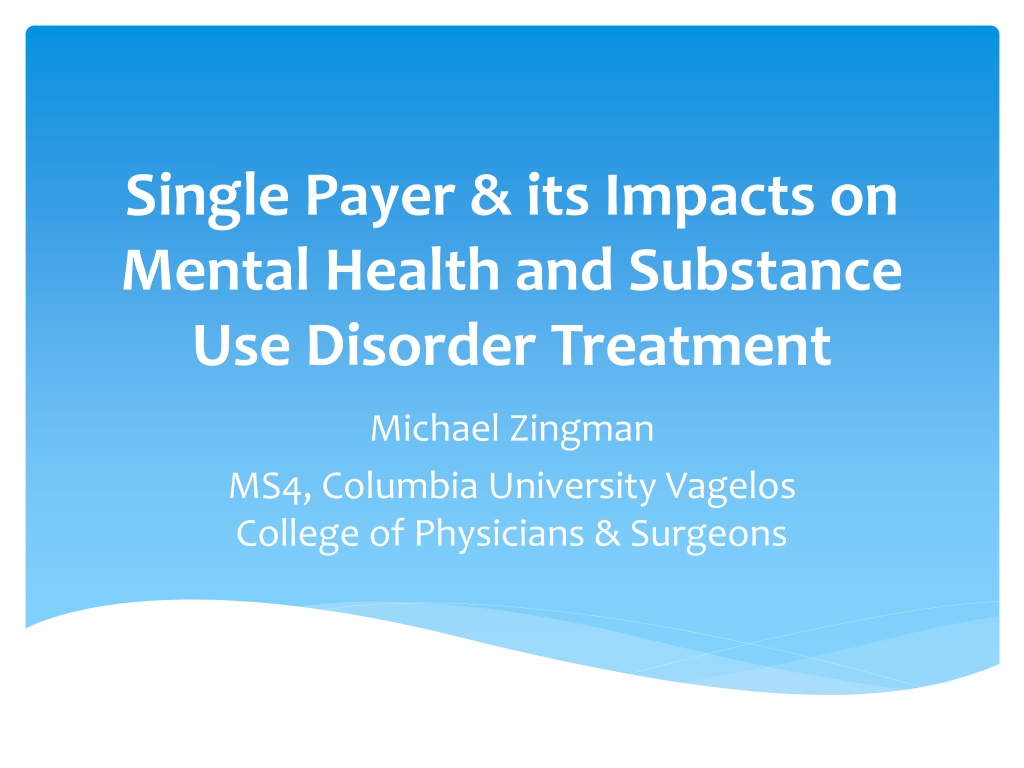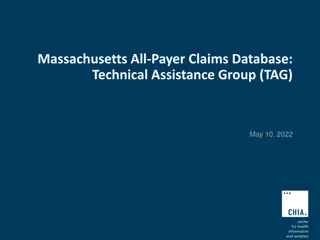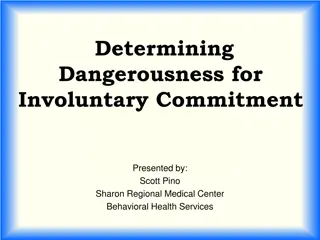Impact of Single Payer System on Mental Health Treatment in the U.S.
Mental health disorders affect a significant portion of the U.S. population, yet access to mental health services remains inadequate, leading to various negative outcomes. This presentation discusses the shortcomings of the current U.S. health system in addressing mental health and substance use disorder treatment, advocating for a single payer system as a solution. It also explores the historical evolution of U.S. health insurance and the challenges faced in providing comprehensive mental health care.
Download Presentation

Please find below an Image/Link to download the presentation.
The content on the website is provided AS IS for your information and personal use only. It may not be sold, licensed, or shared on other websites without obtaining consent from the author. Download presentation by click this link. If you encounter any issues during the download, it is possible that the publisher has removed the file from their server.
E N D
Presentation Transcript
Single Payer & its Impacts on Mental Health and Substance Use Disorder Treatment Michael Zingman MS4, Columbia University Vagelos College of Physicians & Surgeons
Mental Health & Access to Care Mental health disorders are a leading cause of disability in the U.S. 1 in 5 U.S. adults have a mental illness, yet less than 40% of affected adults will receive any mental health services 4 million children/adolescents suffer from a serious mental illness, yet only 1/5threceive MH services Inadequate treatment leads to suffering, homelessness, decreased productivity, suicide and increased costs Higher rates of poverty, uninsurance, under-insurance among individuals with mental illness https://www.ajmc.com/conferences/apa-2018/singlepayer-system-is-the-solution-for-mental-health-care-panelists-say Slide adapted from unpublished report by Dr. Wes Boyd, Dr. Steven Kemble, Dr. Leslie Gise
Discussion Q1: In what ways (that you know of) does the U.S. health system negatively impact mental health and substance use disorder treatment?
Discussion Q2: Why do you think that mental health has been treated differently from physical health in our insurance system?
Evolution of U.S. Health Insurance Blue Cross formed (1936), followed by Blue Shield (1946) WWII: Health benefits linked to employment 1952: IRS rules employer contributions are tax deductible for employers and not income for employees 1950s: Commercial life insurance companies begin selling health insurance to employers https://www.ncbi.nlm.nih.gov/books/NBK235989/ Slides adapted from Dr. Peter Steinglass
Evolution of U.S. Health Insurance 1965: Medicare/Medicaid 1960s-1990s: rising cost of medical care due in part to innovations in medical technology and drugs U.S. remains only industrialized nation without universal healthcare access 1990-2009: non-profit Blue Cross plans convert to for- profit companies; expansion of for-profit managed care limits access + costs keep rising (backlash) Slides adapted from Dr. Peter Steinglass
Mental Health Managed Care Carve-Outs MH services managed by separate entity from medical/surgical services, mostly by Managed Behavioral Health Organizations (MBHO) Primary purpose was to control costs, not improve quality; gate-keepers, pre-authorization become routine 2002: 180 mil people covered by such plans many MH providers refusing to participate in these plans provider shortages https://www.healthaffairs.org/do/10.1377/hpb20140403.871424/full/healthpolicybrief_112.pdf
Mental Health Parity Laws 1996: Mental Health Parity Act I Annual/lifetime limits on MH benefits NO LOWER than medical/surgical benefits (previously no requirement for I insurers to cover MH services AT ALL) Extended 6x up to 2007 2008 (took effect Jan 2010): Mental Health Parity and Addiction Equity Act Health insurers/group plans must guarantee that limits in plans NOT EXCEED those in place for medical/surgical conditions Private insurers responsible for provisions from MH carve-out plans Slides adapted from Dr. Peter Steinglass
ACA No pre-existing conditions exclusion Children covered on parents policies until 26 Mandated list of minimum covered services ACA defined coverage of mental health and substance use treatment as one of the 10 essential health benefits (EHBs) Millions more covered, but millions remain uninsured Insurance premiums continue to rise Slides adapted from Dr. Peter Steinglass
Problems in Current System Despite expanding coverage, the ACA has done little to lower many barriers to appropriate psychiatric care It has not sufficiently changed the predatory practices of insurers that single out individual with mental illness for special restrictions on access to care Private insurers in commercial and Medicaid (managed care) markets require prior authorization for psych treatment more than medical/surgical treatment Insurers limit provider networks and make it difficult to access needed care Co-pays, deductibles, co-insurance are particularly problematic for those with mental illness
Problems in Current System Reimbursement for psychiatric care is LOWER than that of other types of services hospitals that offer psychiatric care often lose money (at least directly) by doing so Health care facilities (not just insurers) obstruct access to outpatient psychiatric care and limit # of inpatient beds Emergency rooms have become de facto psych wards Shift of inpatient psychiatric care to public hospitals
Problems in Current System https://www.treatmentadvocacycenter.org/browse-by-state/colorado
Problems in Current System https://www.treatmentadvocacycenter.org/browse-by-state/colorado
Discussion Q3: How do you think a single payer system would improve upon these mental health parity laws and the ACA to promote better treatment of mental illness and substance use disorders?
MH in Current Legislation HR 1384 (Jayapal) SEC. 204. Coverage of long-term care services. (a) In general. Subject to the other provisions of this Act, individuals enrolled for benefits under this Act are entitled to the following long- term services and supports and to have payment made by the Secretary to an eligible provider for such services and supports if medically necessary and appropriate and in accordance with the standards established in this Act, for maintenance of health or for care, services, diagnosis, treatment, or rehabilitation that is related to a medically determinable condition, whether physical or mental, of health, injury, or age that (1) causes a functional limitation in performing one or more activities of daily living; or (2) requires a similar need of assistance in performing instrumental activities of daily living due to cognitive or other impairments. (b) Eligibility. The Secretary shall promulgate rules that provide for the following: (1) The determination of individual eligibility for long-term services and supports under this section. (2) The assessment of the long-term services and supports needed for eligible individuals. (c) Services and supports. Long-term services and supports under this section shall be tailored to an individual s needs, as determined through assessment, and shall be defined by the Secretary to (1) include any long-term nursing services for the enrollee, whether provided in an institution or in a home and community-based setting; (2) provide coverage for a broad spectrum of long-term services and supports, including for home and community-based services and other care provided through non-institutional settings; (3) provide coverage that meets the physical, mental, and social needs of recipients while allowing recipients their maximum possible autonomy and their maximum possible civic, social, and economic participation SEC. 201. Comprehensive benefits. (a) In general. Subject to the other provisions of this title and titles IV through IX, individuals enrolled for benefits under this Act are entitled to have payment made by the Secretary to an eligible provider for the following items and services if medically necessary or appropriate for the maintenance of health or for the diagnosis, treatment, or rehabilitation of a health condition: (1) Hospital services, including inpatient and outpatient hospital care, including 24-hour-a-day emergency services and inpatient prescription drugs. (2) Ambulatory patient services. (3) Primary and preventive services, including chronic disease management. (4) Prescription drugs and medical devices, including outpatient prescription drugs, medical devices, and biological products. (5) Mental health and substance abuse treatment services, including inpatient care. (6) Laboratory and diagnostic services. (7) Comprehensive reproductive, maternity, and newborn care. (8) Pediatrics. (9) Oral health, audiology, and vision services. (10) Rehabilitative and habilitative services and devices. (11) Emergency services and transportation. (12) Early and periodic screening, diagnostic, and treatment services (13) Necessary transportation to receive health care services for persons with disabilities or low-income individuals (as determined by the Secretary). (14) Long-term care services and support (as described in section 204). SB 1129 (Sanders) (b) Institutional long-Term care services defined. In this section, the term institutional long-term care services means the following: (1) Nursing facility services for individuals 21 years of age or over described in subparagraph (A) of section 1905(a)(4). (2) Inpatient services for individuals 65 years of age or over provided in an institution for mental disease described in section 1905(a)(14). (3) Intermediate care facility services described in section 1905(a)(15). (4) Inpatient psychiatric hospital services for individuals under age 21 described in section 1905(a)(16). (5) Nursing facility services described in section 1905(a)(29).
Impacts of Single-Payer (as per PNHP s Physicians Proposal) All U.S. residents covered Comprehensive benefits, including all physical and MENTAL health care, rehab and LONG TERM CARE (no arbitrary coverage limits) Better access without co-pays/deductibles/premiums All providers included in plan, no restricted networks Global operating budgets for clinics, hospitals and specialized programs for substance use Clinicians get paid salaries in these settings https://pnhp.org/what-is-single-payer/physicians-proposal/
Possible Impacts of Single-Payer Independent practice clinicians would be paid on fee-for-time basis, including documentation and care coordination, to be incentive-neutral (not fee-for-service) Funding/incentives for hospitals to expand mental health care based on community need Pharmaceuticals No co-pays for psychiatric medications on formulary Prior auth only applying to drugs with inappropriate use for reasons other than medical necessity Bulk purchasing and negotiations to control drug prices More incentive to prioritize research towards treatment of SMI https://pnhp.org/what-is-single-payer/physicians-proposal/
Discussion Q4: What needs to be done beyond the adoption of a single payer system (or needs to be added to single payer legislation) to improve mental healthcare?
What Else is Needed TRUE mental health parity (with ENFORCEMENT) Mental Health Parity Compliance Act https://www.healthaffairs.org/do/10.1377/hpb20140403.871424/full/healthpolicybrief_112.pdf
What Else is Needed Increase # of MH practitioners Increase of inpatient psychiatric beds Increased focus on treatment of serious mental illness (SMI), including education/training of providers Integrated care mental health care embedded in primary care and general medical settings Elimination of for-profit hospitals Incentives, funding for innovation/pilot programs to expand access to community-based services for SMI https://www.healthaffairs.org/do/10.1377/hpb20140403.871424/full/healthpolicybrief_112.pdf
What Else is Needed Expand access to substance use treatment Improve coordinated care - allow providers to share patient s substance use records with other members on health care team Funding increases for research into child and adolescent psychiatric disorders & treatment options Expansion of loan forgiveness programs for child and adolescent psychiatry trainees Increased federal support for training programs via GME funds https://www.nami.org/getattachment/Learn-More/Mental-Health-Public-Policy/Public-Policy-Platform-December-2016-(1).pdf https://www.mhanational.org/position-statements https://www.treatmentadvocacycenter.org/fixing-the-system
What Else is Needed Criminal justice reform Decriminalization of marijuana and opioid use Supportive housing Immigration reform Increased training and research for addiction treatment Increased case managers and peer specialists Expansion of school-based mental health programs Expansion of behavioral health workforce Increase funds for suicide prevention and awareness Invest in veteran mental health Expand telepsychiatry to alleviate geographic disparities Expand first-episode psychosis programs https://www.nami.org/getattachment/Learn-More/Mental-Health-Public-Policy/Public-Policy-Platform-December-2016-(1).pdf https://www.mhanational.org/position-statements https://www.treatmentadvocacycenter.org/fixing-the-system
Discussion Q5: How can the single payer movement better focus on AND advocate for improved mental healthcare? Q6: How can we bring individuals and families affected by mental illness/substance use disorders into the movement?
JAN 30 EVENT: NAMI-NYC & Campaign for NY Health
Opportunities for Advocacy Local + State NAMI Chapters, National NAMI Community-based mental health and substance use treatment and advocacy organizations Treatment Advocacy Center national, state, local Professional Organizations: American Psychiatric Association (APA) American Academy of Child & Adolescent Psychiatry (AACAP) American Academy of Community Psychiatrists (AACP) PNHP Mental Health Proposal























